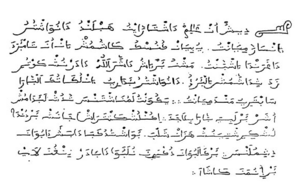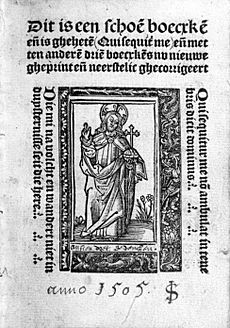Young Man of Arévalo facts for kids
Quick facts for kids
Young Man of Arévalo
|
|
|---|---|
| Born | uncertain, late 15th/early 16th century Arévalo, Crown of Castile (in today's Spain) |
| Died | uncertain, possibly second half of 16th century uncertain, possibly Aragon |
| Pen name | Young Man of Arévalo Mancebo de Arévalo |
| Subject | Islam, Moriscos |
| Years active | 16th century |

The Young Man of Arévalo (Spanish: el Mancebo de Arévalo) was a Morisco writer from Arévalo, Castile, in what is now Spain. He was a crypto-Muslim, meaning he secretly practiced Islam after Muslims were forced to become Christians. He wrote more Islamic books than any other known author in Spain during this time.
He traveled all over Spain to visit other secret Muslim communities. He wrote several books about Islam, including stories from his journeys. We don't know his real name or exactly when he was born or died. Most of his travels happened in the first half of the 1500s.
Contents
Who Was the Young Man of Arévalo?
Early Life and Travels
The Young Man was born in Arévalo. His mother had been made to convert to Christianity. We don't know his exact birth year. He grew up after the Reconquista ended in 1492, when the city of Granada fell. This was also when Muslims in Castile were forced to convert to Christianity between 1500 and 1502.
When he was young, he traveled to almost every part of Spain. He could not visit areas along the coast because he was a Morisco. He visited many places like Alcántara, Almagro, Astorga, Ávila, Gandia, Granada, Jaén, Ocaña, Requena, Ronda, Segovia, and Zaragoza.
Collaborations and Knowledge
In the 1530s, he worked with Bray de Reminjo. Bray was a religious scholar (a faqih) from Cadrete in Aragon. Together, they wrote an Islamic religious guide called Brief compendium of our sacred law and sunna. By this time, people thought of him as a respected writer.
Bray de Reminjo said the Young Man was "intellectual." He was from Arévalo and spoke Spanish very well. He also knew aljamiado, which is Spanish written with Arabic letters. He could also read Arabic, Hebrew, Greek, and Latin. His writings show he knew the Quran well. He also knew Christian books like The Imitation of Christ by Thomas à Kempis and the medieval novel La Celestina. He probably knew Christian works because he had to attend missionary sermons.
Secret Practices and Hopes
His travel stories include taking part in a secret group prayer (salat jama'ah) in Zaragoza. He met with important Muslim leaders and preachers, including some women. He also collected money to help people go on pilgrimage to Mecca. We don't know if he ever made it to Mecca. It was against the law for Moriscos to leave the country. In his writings, he strongly believed that Islam was the true faith. He hoped it would become strong in Spain again during his lifetime.
What Did He Write?
The Young Man of Arévalo wrote at least three books that we still have today. These are the Brief compendium of our sacred law and sunna (around 1533), the Tafsira (around 1533), and the Summary of the Account and Spiritual Exercise (shortly before 1550). All his books were written in Spanish using Arabic letters (aljamiado). They were mainly about religious topics.
Besides religious content, his books also included stories from his travels. He wrote about meeting other secret Muslims and described their religious practices and discussions. These stories help historians learn about the crypto-Muslim community in 15th-century Spain.
Main Works
- The Brief Compendium is about fiqh (Islamic law). It covers topics like ibadah (Islamic worship) and Islamic economics. He wrote it with Bray de Reminjo. This was a rare time when Castilian (Young Man) and Aragonese (Bray) Muslim traditions worked together.
- The Tafsira is a tafsir, which is a commentary or explanation of the Quran.
- The Summary is a religious book about devotion and being pious.
A Spanish scholar named Pascual de Gayangos y Arce said in 1839 that he saw another book by him called The Pilgrimage of the Young Man in Madrid. However, this book is now lost.
Christian Influences
In 1980, a Spanish author named Gregorio Fonseca Antuña found something interesting. He noticed that parts of the Summary were very similar to parts of The Imitation of Christ. This 15th-century book by Thomas à Kempis is a Christian devotional book. The Young Man often changed these parts to fit Islamic ideas. He kept the spiritual and moral meaning, but replaced Christian details with Islamic ones.
These similarities are found throughout the book, even in long sections. Historian L. P. Harvey confirmed that Kempis's influence was "beyond doubt." It could not have been a coincidence. The Young Man did not say he got these ideas from Kempis. He often said Islamic scholars like al-Ghazali and Ibn Arabi wrote them, which was misleading. He might have used Christian devotional books because he had to go to missionary sermons. Also, he might not have had many Islamic books available. His other works, unlike the Summary, show a lot of original ideas.
Who Was He Really?
Historian L. P. Harvey thought that the Young Man of Arévalo might be the same person as Agustín de Ribera. Agustín was a Morisco from Arévalo who said he was a prophet. He was also called el mozo (the lad). However, Harvey admitted that this idea had many problems he could not solve. Agustín was investigated by the Spanish Inquisition in 1540, and records from his questioning still exist.
His Importance
The Young Man's writings became well-known among the Morisco community. He became famous as a scholar. People copied his books until the end of the 1500s. Other Morisco writers mentioned his works until the early 1600s, just before the expulsion of the Moriscos.
He was the most active known Islamic writer in Spain after Muslims were forced to convert. Today, historians often study his works when looking at Morisco literature from that time.
|
See also
 In Spanish: Mancebo de Arévalo para niños
In Spanish: Mancebo de Arévalo para niños


